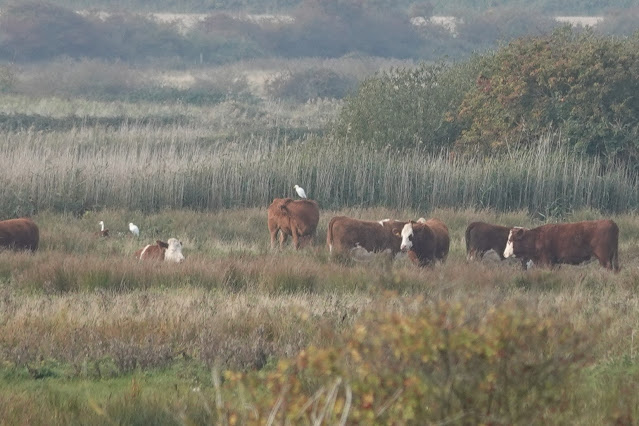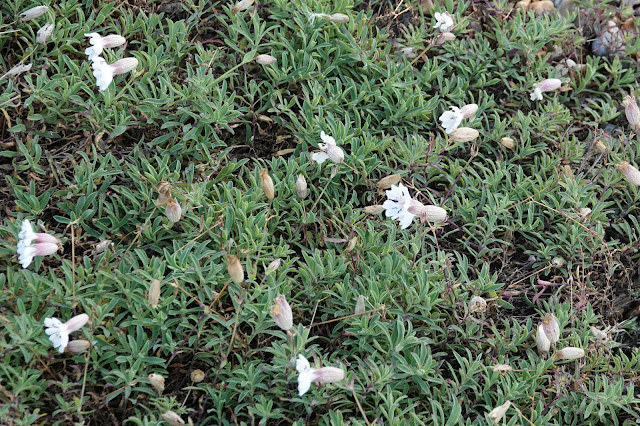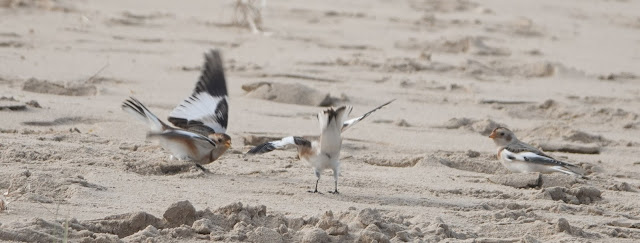14th October:
After spending the evening at Enid’s new house in Wymondham
on Thursday night, it meant I only had an hour run to get to Holkham and Lady
Anns Drive for 7.30. The journey up through the first hint of light produced
both Tawny and Little Owls across the road and before too long a procession of
kamikaze Pheasants.
I was greeted at Holkham by thousands of Pink-feet heading
out for the day and thankfully there were plenty left and actually still coming
in when my crew for the day arrived. It
was eerily calm and we quickly picked up Goldcrest, Chaffinches and the odd
incoming Redwing and Song Thrush while I had also seen a Brambling. Wood Pigeons and Jays were in the Holm Oaks –
the first simply eating the small acorns while the latter were filling crops before
heading off for some suitably loamy soil to hide them in.
 |
| Pink-feet |
 |
| Wood Pigeons |
Pinkies accompanied us on the whole walk down the inside of
the pines with the ‘nudge nudge wink wink’ echoing through the trees. The only passerines were locals with Coal,
Blue, Great and Long-tailed Tits and a few angsty Goldcrests. The odd Skylark and Meadow Pipit passed over
but with 12 days of westerly incoming birds were going to be thin on the
ground.
The pond was full of displaying Gadwall and a few other ducks
and Little Grebe and we could see Chinese Water Deer, Muntjac, Marsh Harriers, Buzzards
and a Great White Egret out on the marshes while up above Red Kites drifted
east down the pines, watching us with careful scrutiny. How the fortunes of this magnificent raptor
have changed.
 |
| Red Kite |
 |
| Chinese Water Deer |
 |
| Koniks |
Common Darters and Migrant Hawkers were noted along with
Small White, Red Admiral and a Wall Brown down at the beach where the flat sea
of Holkham Bay allowed us to get good
views of Red-throated Divers, Razorbills and Guillemots, Great Crested Grebes,
Gannets and a few Common Scoter.
 |
| Wall Brown |
 |
| Common Darter |
Fighters were tearing the air asunder above us in mock dog
fights and you could quite literally not make yourself heard let alone hear
anything else. I can only imagine what
it sounded like way up there.
Post planes,
a Stonechat called from the dunes but could not be found and Skylarks, Meadow
Pipits, Siskin and Linnets were all encountered along with an invisible calling
Treecreeper before we returned to the main path. A squint over the wall by the
Joe Jordan hide added Cattle and Little Egret and anther Great White with four,
two and one respectively all feeding in and on the herd of cows.
 |
| two Cattle and a Great White Egret |
We ambled back with nearly four hours frittered away on a
most pleasant walk with a few minutes spare for a cuppa before heading west towards
Titchwell.
Lunch in the car park was accompanied by fly over Redpolls, Siskins
and skeins of Golden Plover before a walk down the public footpath to the
beach. Bearded Tits were heard but they were staying low and out towards Thornham
Point a Red Kite was tucking into something substantial on the top of the old
concrete building. A second Kite came in to see what it found and a tussle
ensued and attracted attention from the Marsh Harriers.
 |
| Squabbling Kites |
The freshmarsh was home to the usual dabbling
ducks along with Black-tailed Godwits, Ruff and Avocets while the new bunds
designed to split the area into three were covered in a spangly carpet of equidistantly
spaced Golden Plover. The susurration of their conversationalist calls
and the breeze through the reeds was the aural backdrop of the visit.
 |
| Black-tailed Godwit |
 |
| Ruff |
 |
| Golden Plover |
 |
| young Shelduck |
A couple of Great White Egrets popped up now and then from
the main reedbeds and three Brent Geese were the first we had seen although
down on the beach there were several small parties along the foreshore amongst the
Sanderlings, Grey Plovers, Oystercatchers and Bar-tailed Godwits.
Up at the highest tideline six Turnstone were energetically
sorting through the dried seaweed and were completely unphased by our presence
and a scan up the beach after the hoped for Snow Bunting flock revealed them
quite literally feeding around the legs and tripod of a couple sitting up by
the dunes. We approached closer and the flock of nine came to see us. Several were undoubtedly males with much paler
almost grey streaky back and huge amounts of white in the wing. They were often
bickering and would flutter up of the ground like little bits of white paper
caught in a whirlwind. It is very easy
for Snow Bunts to be the highlight of any day.
 |
| Turnstones |
 |
| Turnstone |
 |
| Snow Buntings |
We had a good catch up with Alan Davies and Ruth Miller and
their party before a slow walk back in the cooling air. It was still clear to the west and we had
somehow escaped the wet front that had moved over us and was now drenching Brancaster
and beyond to the east. We stood and watched
the reedbed and pools for a while hearing a Kingfisher and Reed Buntings and
getting another Great White Egret view.
The Golden Plover flock doubled with another big flock arriving and a
Water Rail scurried and half flew across one of the channels.
 |
| Great White Egret |
 |
| Golden Plover |
It was a very calming end to the day. We went our separate ways and I planned my
route back to Wymondham and as I drove past the Burnham Overy Dunes layby a flock of
Grey Partridge flew across the road and I had enough time to stop and watch
them – nine in all – as they fed in a ploughed field, blending in perfectly with
the odd piece of stubble and broken flint. Ten Red-legged Partridges flew the
other way and with the golden hour approaching I decided to stay a while and
scan the marshes.
 |
| Grey Partridges |
A flock of 21 Barnacle
Geese were loosely with the Pinkfeet and skeins of the latter were already
dropping in from all directions while somewhere off inland I could hear the
murmur of a huge number of geese. Marsh
Harriers, Kestrels and Buzzards were seen and the Egrets were still with their
cattle – albeit a wee bit further away.
A couple of Yellowhammers called from the hedge line but I had to wait
for my journey back through the lanes to eventually see a ghostly Barn Owl
quartering a grassy field.
 |
| Pinkfeet |
A glorious curry awaited my return!
15th October:
Antony met me at Enid’s at 7.15 on a murky dank morning with
the sound of a few Redwing and a Grey Wagtail to add to her new garden
list. The journey up to Kelling went without incident and we were soon parked under the fig tree in The Street to
wait for the rest of the party who all arrived on time. It was still grey and cool as we walked down
the track to the pool and it felt like rain but thankfully it never materialised. Bullfinches were heard and seen (for a change)
and three Fieldfares were the first of my autumn but as expected it was fairly
quiet with just a couple of Goldcrests and the odd finch.
Gangs of Red-legs broke the skyline in every field we looked
at and Brown Hares lolloped into view now and then disturbing flocks of Skylarks
and Meadow Pipits.
The pool had the usual dabblers and a bonus juvenile Goldeneye
which we later gathered was a proper local rarity for the site. It was very unsure what to do when all the
duck got spooked by a helicopter and ended up staying put.
 |
| Goldeneye |
A pair of Stonechat were found and a third bird was quite
intriguing with a warm apricot flush, pale throat, feeling of a supercilium, obviously
stripy back and quite possibly plain rump.
It was too dark for a Siberian but I did wonder about the other Eastern
Stonechat possibilities. It looked good
in the scope but I failed to get any meaningful images and we lost it after a
few minutes partly because a perched Kingfisher interrupted proceedings.
 |
| The Stonechat that piqued my interest |
Down at the sea it was predictably calm and quiet but once
again we got good views of the same suite of species as at Holkham yesterday
with the addition of a single adult Little Gull and a couple of incoming
Starlings and Skylarks.
 |
| The enthusiasm for sea-watching was unbridled |
 |
| We cheered this Starling when it safely made it over the beach |
A short photoshoot with a Merveille de Jour that Antony had brought
with him took place on a piece of beach driftwood before we made our way back the
way we had come. The sun was now out and
there were many more insects on the Ivy and such like with countless Honey Bees
and Wasps, a few Pollenia and Lucilia and the odd Syrphus Hoverfly. Common Darters
and Migrant Hawkers were noted along with a very good selection of moth leaf
mines that I shall add here once Antony sends them over. It would have been rude not to have tea and cake at the Old
Reading Rooms and sit outside with passing Golden Plovers and Buzzards and a
couple of extra Beech leaf mines to add to Antony’s list.
 |
| Merveille de Jour |
 |
| Migrant Hawker |
 |
| Syrphus sp |
 |
| Pied Wagtail - Antony Wren |
West now to Gramborough Hill for the off chance that we
could find the two Snow Buntings for Gill (her bogey bird). We looped around the
hill being distracted by some fine Parasol Mushrooms in various states of
magnificence when I realised that Antony had been trying to ring me – he had the
Snow Bunts on the cliff face. A couple
of minutes later we were watching eight of these entrancing birds as they fossicked
on the actual cliff face of the Hill where they seemed to be finding plenty of
seed to nibble on. Gill was beaming.
 |
| Parasol - fully ten inches across |
 |
| Snow Buntings - challenging as in full shade AND into the sun above the cliff! |
 |
| Snow Bunting - Antony Wren |
Three Red-throated Divers fed and preened just off shore before
we retraced our steps taking in mats of Sea Campion and vibrant red Salicorna
and glaucous leaved Yellow-horned Poppies.
 |
| lobster pot - Antony Wren |
 |
| Sea Campion |
 |
Redshank - it was a bit breezy
|
 |
| Red-throated Diver - Antony Wren |
Black-headed Gulls joined us for
lunch and Simon rescued my errant lunch wrapper from the ditch that had been
whisked from the boot of my car by the ever increasing wind by using some
skilful balancing and an umbrella.
 |
| Black-headed Gulls |
 |
| Black-headed Gull and Giant Hula-hoop - Antony Wren |
 |
| Bravo Simon! |
Walsey Hills and the East Bank was our last stop and somehow
we all got parked in the layby of the former and were soon watching a most
splendid Jack Snipe on, well Snipes Marsh, doing what they do best. It was
fully in the open and I suspect it was the best views that most of the party
had ever had. Flocks of Stock Dove, Wood Pigeons
and Ruff periodically appeared from the field behind.
 |
| Jack Snipe - two different birds |
The wind was slightly awkward as we then walked down to the
sea but we still managed to collect a very good selection of waders with a
single Curlew Sandpiper amongst some very long billed Dunlin, Ringed and Grey
Plovers, Avocets and Blackwits, Snipe, Redshanks and lots of different sized
Ruffs.
Something kept causing all the
Wigeon and Teal to dread and we picked up a couple of Pintail at the end along
with dashing Kingfisher, Rock Pipit, a pair of Stonechats and the odd invisible Bearded
Tit.
 |
| Avocet |
Marsh Harriers zig zagged over the
silver shining phragmites and Pinkfeet constantly moved between Blakeney and the
inland field with odd parties drifting our way too. We just missed an Otter on the algal filled
channel and the six Little Grebes there remained motionless with necks
upstretched for twenty minutes afterwards so perhaps they could see where the
predator was lurking. The sea added nothing new bar a small party of Brents so
we headed back for a last look at the now two Jack Snipe – Bob and Bobette as
they bounced out of time with each other.
 |
| Pinkfeet |
Once again we had spent a whole day in Norfolk in just a
mile and a half of coastline and despite the generally unfavourable autumnal
conditions we fared well and everyone went away happy before their journeys
home in a variety of directions.























































































No comments:
Post a Comment